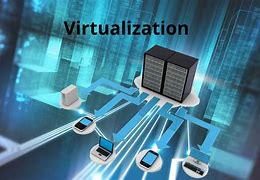Virtualization
 Ezuma Grace
Ezuma Grace
Virtualization is a mechanism for decoupling a service from its underlying physical delivery. It is the process of generating a virtual representation of something, such as computer hardware. It was first created during the mainframe era. It entails the use of specialized software to generate a virtual or software-generated version of a computing resource rather than the actual version of the same resource. Multiple operating systems and applications can run on the same machine and hardware at the same time thanks to virtualization, enhancing device usage and flexibility. In other words, virtualization is one of the primary cost-effective, hardware-reducing, and energy-saving approaches utilized by cloud providers. Virtualization allows several consumers and organizations to share a single physical instance of a resource or application at the same time. It accomplishes this by giving physical storage a logical name and supplying a pointer to that physical resource on demand. The term virtualization is frequently used interchangeably with hardware virtualization, which is critical in successfully offering Infrastructure-as-a-Service (IaaS) solutions for cloud computing. Furthermore, virtualization technologies enable a virtual environment not just for program execution but also for storage, memory, and networking.
• Host Machine: The machine on which the virtual machine will be developed is referred to as the Host Machine.
• Guest Machine: A virtual machine is known as a Guest Machine.
Hypervisor
The hypervisor, which is in charge of controlling and assigning physical resources to virtual computers, is a critical component of virtualization.
Hypervisors are classified into two types:
• Type 1 Hypervisor: Runs on the host hardware (bare metal). VMware ESXi, Xen, and Microsoft Hyper-V are a few examples.
• Type 2 Hypervisor: Runs on top of an already installed operating system. VMware Workstation, Oracle VirtualBox, and Parallels Desktop are a few examples.
Virtual Machine.
A Virtual Machine (VM) is a piece of software that emulates a physical computer.
Virtual machines (VMs) have their own operating systems, applications, and resources.
They are separate from one another and can run various operating systems on the same physical hardware.
Virtualization at Work in Cloud Computing
Virtualization is having a significant impact on cloud computing. they store data in the cloud when using cloud computing, but with the help of virtualization, they have the added benefit of sharing infrastructure. Cloud vendors supply the necessary physical resources, however, these cloud providers charge exorbitant fees for these services, which affects every user or company. Virtualization assists Users or Organizations in maintaining those services necessary by a firm through external (third-party) individuals, hence lowering the company's costs. This is how Virtualization works in Cloud Computing.
Benefits of Virtualization
• More flexible and efficient resource allocation.
• Boost development productivity.
• It brings down the cost of IT infrastructure.
• Scalability and remote access.
• Disaster recovery and high availability.
• On-demand access to IT infrastructure.
• Support for numerous operating systems.
Drawback of Virtualization
While virtualization has numerous advantages, it also has certain drawbacks, including:
• High Initial Investment: Clouds have a high initial investment, but it is also true that it will help firms reduce costs.
• Learning New Infrastructure: As businesses transition from servers to the cloud, they need highly skilled employees who can easily operate with the cloud, which necessitates hiring new employees or educating current employees.
• Data Risk: Hosting data on third-party resources puts the data at risk, as it is vulnerable to being attacked by any hacker or cracker.
• Performance Overhead: Due to resource sharing, VMs' performance may be slightly lowered.
• Security Issues: Hypervisor flaws can cause security issues.
• Licensing and Compliance: Managing VM licenses can be difficult.
• Competing for Resources: VMs on the same host can compete for resources.
Virtualization Characteristics
• Enhanced security: The ability to entirely transparently manage the execution of a guest program offers up new avenues for providing a secure, controlled execution environment. All guest program operations are typically done against the virtual machine, which subsequently translates and applies them to the host applications.
• Managed Execution: The most important features are sharing, aggregation, emulation, and isolation.
• Sharing: With virtualization, you can create a different computer environment on the same host.
• Aggregation: While physical resources can be shared among multiple guests, virtualization also allows for aggregation, which is the opposite operation.
Types of Virtualization
• Application Virtualization
• Network Virtualization
• Desktop Virtualization
• Storage Virtualization
• Server Virtualization
• Data virtualization
- Application Virtualization: Application virtualization enables a user to view an application from a server remotely. The server saves all personal information and other program characteristics, yet it can still be run on a local desktop over the internet. A user who needs to run two separate versions of the same software is an example of this. Hosted apps and packaged applications are examples of application virtualization technologies.
2. Network Virtualization: The capacity to manage many virtual networks, each with its own control and data plan. It coexists on top of a single physical network. Individual parties that are possibly confidential to each other can manage it. Network virtualization enables the creation and provisioning of virtual networks, logical switches, routers, firewalls, load balancers, Virtual Private Networks (VPN), and workload security in a matter of days or weeks.
3. Desktop Virtualization: Desktop virtualization allows users' operating systems to be remotely stored on a data center server. It enables the user to virtually access their desktop from any location using a separate machine. Users who require operating systems other than Windows Server will require a virtual desktop. The primary advantages of desktop virtualization are user mobility, portability, and the ease with which software installation, updates, and patches may be managed.
4. Storage Virtualization: Storage virtualization is the management of a group of servers by a virtual storage system. The servers have no idea where their data is stored and instead perform more like worker bees in a hive. It allows storage from numerous sources to be managed and used as a single repository. Despite modifications, breakdowns, and variances in the underlying equipment, storage virtualization software ensures smooth operations, consistent performance, and a continuing array of sophisticated functions.
5. Server Virtualization: This is a type of virtualization in which server resources are masked. By changing the identity number and processors, the central server (physical server) is partitioned into numerous different virtual servers. As a result, each system can run its operating systems independently. Where each sub-server is aware of the primary server's identity. It improves performance while lowering operational costs by deploying main server resources to a sub-server resource. It helps with virtual migration, lowering energy consumption, lowering infrastructure expenses, and so on.
6. Data Virtualization: This is the type of virtualization in which data is collected from multiple sources and managed in a single location without knowing more about the technical information such as how data is collected, stored, formatted, and then arranged logically so that its virtual view can be accessed remotely by its interested people, stakeholders, and users via the various cloud services. Many large corporations, including Oracle, IBM, At Scale, Cdata, and others, offer their services.
Uses of Virtualization
• Data Integration: Data virtualization combines data from several sources without replicating or moving it, providing users with a single virtual layer that spans numerous applications, formats, and physical locations.
• Business Integration: Business integration is a strategy that aims to connect technology with the business's strategy and goals through synchronizing IT and business cultures and objectives. Business integration reflects how information technology is used as a business function.
Service-oriented Architecture Data-services: Service-oriented architecture (SOA) is a software development strategy that uses software components known as services to create business applications. Each service offers a business capacity, and services can communicate across platforms and languages. SOA is used by developers to reuse services across systems or to integrate numerous independent services to complete complex tasks.
Use Cases
Virtualization finds applications in various areas:
Data Centers: Consolidate servers and optimize resource usage.
Cloud Computing: Create and manage virtual instances in the cloud.
Development and Testing: Quickly set up testing environments.
Desktop Virtualization: Provide remote access to desktops.
Disaster Recovery: Ensure business continuity with VM snapshots.
Future Trends
With developing technologies such as containerization (e.g., Docker and Kubernetes) and serverless computing, virtualization continues to evolve.
These technologies strive to improve resource consumption while also making deployment and scalability easier.
Conclusion
Finally, virtualization is a fundamental technology that has altered the IT world. It allows for more efficient resource usage, cost savings, and greater flexibility in managing computing resources. Virtualization will expand alongside technology, providing even more opportunities and breakthroughs in the world of computing.
Subscribe to my newsletter
Read articles from Ezuma Grace directly inside your inbox. Subscribe to the newsletter, and don't miss out.
Written by

Ezuma Grace
Ezuma Grace
I am a Cloud Engineer, Cybersecurity Analyst, Technical Writer and an IT Support Engineer